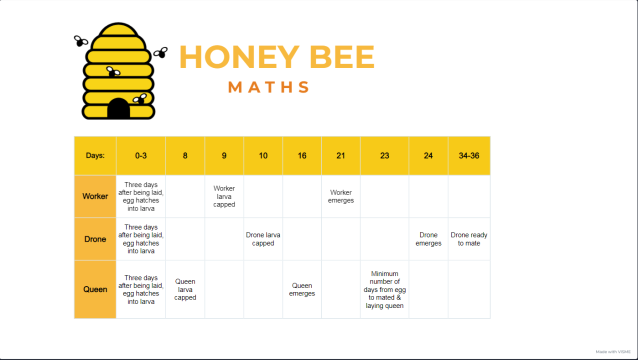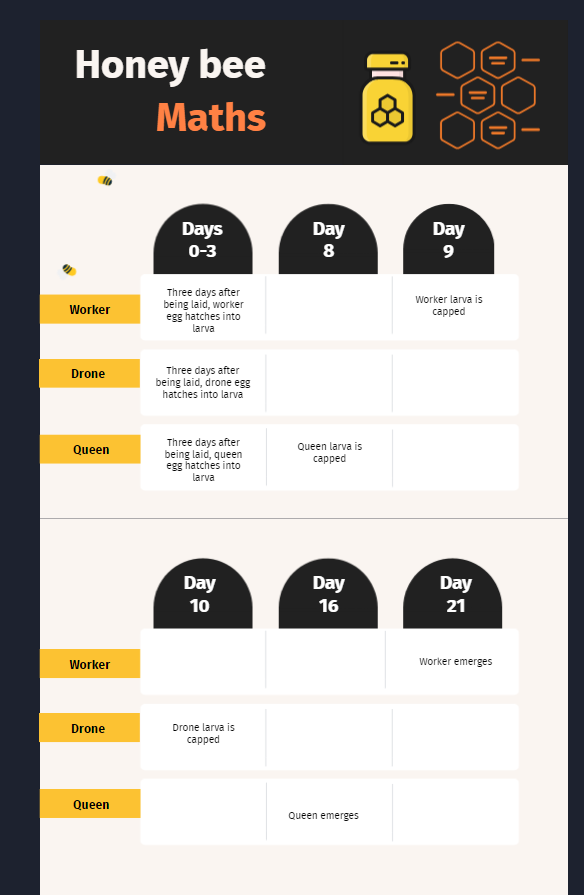I’ve been doing some more playing around with the Visme infographic maker and produced these as a little reminder for myself of some ‘bee maths’. Memorising the number of days it takes for an egg to hatch, the larva’s cell to be capped over and the new bee to emerge is very helpful for a beekeeper.
For instance, if you see one egg at the bottom of the cell that tells you a queen has been laying eggs in the past three days (multiple eggs per cell might be either a new queen just getting started, or more likely laying workers).

These two charts below were my first attempt, before I discovered a more suitable template in Visme. I prefer the look of the charts below but think it’s more practical to have it all in one horizontal chart.
Many thanks to David at The Apiarist blog, whose post Timing is everything was very helpful for reminding myself of some of these timings!
Are there any more timings I should add in, that you find helpful when beekeeping?



Nice graph. I learned a quick mnemonic 3-5-8-5-3, which lets you remember the full lifecycle:
– egg dissolves into larva in 3 days
– larva is capped in 3+5 = 8 days
– queen emerges in 3+5+8 = 16 days
– worker emerges in 3+5+8+5 = 21 days
– drone emerges in 3+5+8+5+3 = 24 days
Pretty cool, huh?
Erik
LikeLiked by 1 person
Hi Erik, sorry to take so long to reply. That is a good one!
LikeLiked by 1 person
I suppose you could add along the timeline when the bees take on nursing duties up to when they become foragers. That can be good to know.
I envy beekeepers who have instant recall of all these numbers. In university, I learned how to memorise figures and formulas and dates, but just long enough to pass the exam. Most of the numbers would be gone from my head a month later.
Every year as a beekeeper, I try to memorise all the bee basics in terms of biological development and bee duties within the hive, and so on, and it just doesn’t stick. I have a grasp of the fundamentals and can predict within a few days what I need to predict (queen emergence, etc), but my brain gets lost in the weeds once I have to add up more than two numbers. It’s pathetic. I have students who know all the beekeeping numbers and dates better than me.
I need to embrace my shame and put up charts like this all around my beeyard as reminders.
LikeLike
That’s a good idea, I’ll try to add the bee jobs in at some point.
We’re all good at different things, I bet you have tons of other beekeeping skills 🙂
LikeLike
Hi Emily … thanks for the mention. I’m just putting something together on the timing of what happens after they emerge, or – more specifically – the lifespan of adult bees.
In the revamp of my site I have a feeling your subscription email didn’t make it into the new system because you were registered to receive new post announcements through wordpress.com. WordPress was a bit shambolic in not exporting a few hundred subscribers … one of the many reasons I’ve switched.
Anyway … the address is the same as it always was and you and Thomas Bickerdyke were two of my original followers.
Cheers
David
LikeLike
Hi David, thanks for letting me know 🙂 Hadn’t realised me and Tom were two of your original followers! I am falling behind on my bee reading nowadays, with two young kids – hopefully in a few years I’ll have more time to read!
LikeLike
Hi Emily,
It’s nice to see you posting occasionally about bee things! I follow your ‘Cornwellian’ insights with voyeuristic delight. I know how it is when life gets in the way of blogging, but you have fans who enjoy hearing about your garden, life, and bees!
Best wishes,
Ron
LikeLike
Thanks Ron, that’s so kind. I keep flip-flopping about whether to give up on the beekeeping or not, to be honest. It doesn’t help that climate change seems to be affecting UK weather and Cornwall is extremely wet. It rains most days – not great for beekeeping!
LikeLike